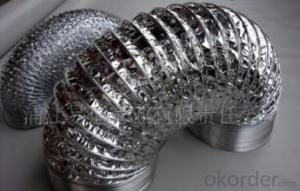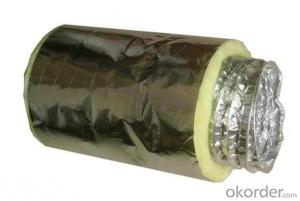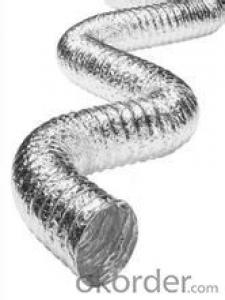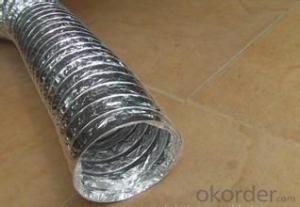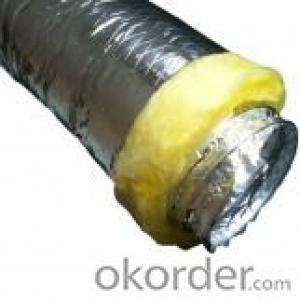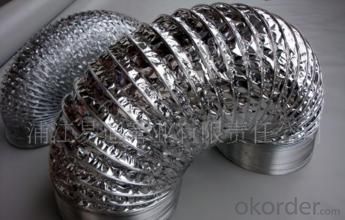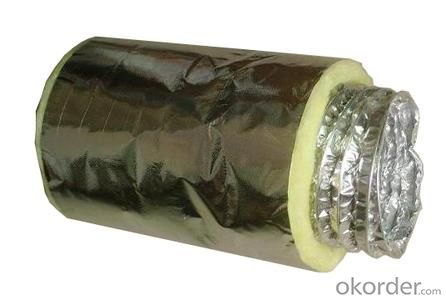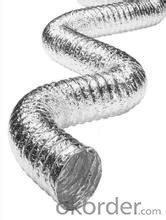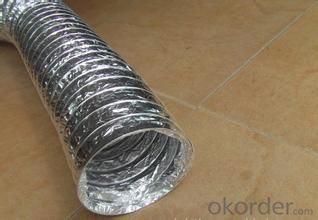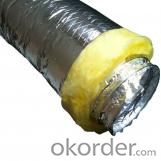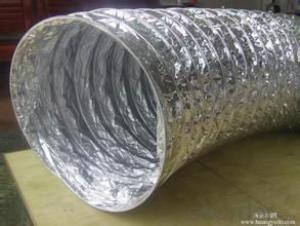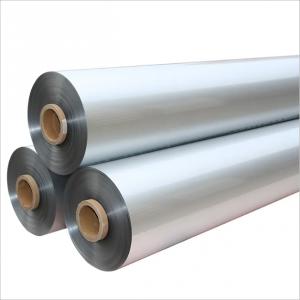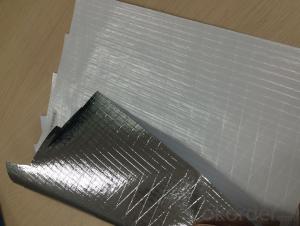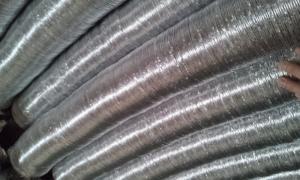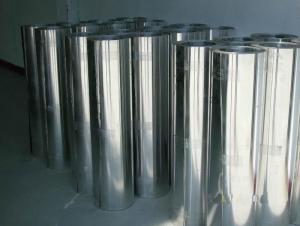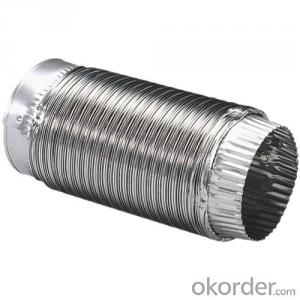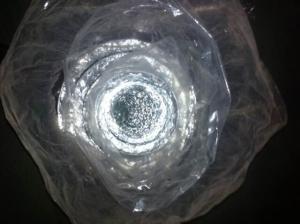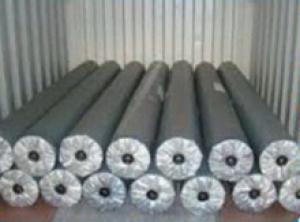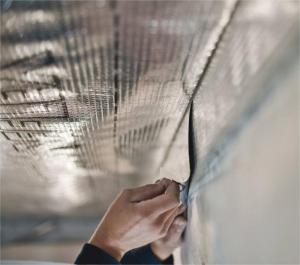Aluminum Foil Facing Insulated Flexible Ductings HVAC Ducting for Air Conditioning
- Loading Port:
- Shanghai
- Payment Terms:
- TT or LC
- Min Order Qty:
- 500 pc
- Supply Capability:
- 50000 pc/month
OKorder Service Pledge
OKorder Financial Service
You Might Also Like
Product Description:
Features and Characters of Aluminium Flexible Duct:
-Non-insulated and insulated Flexible Duct offered
-Up to 150℃ and 250℃ high temperature
Description and specification of Aluminium Flexible Duct
Non-insulated Flexible Duct: Structure: Two-layer aluminum foils +1 layer of PET film.
Insulated Flexible Duct
Structure: 1 layer of Alu. Foil+1 layer PET film+ glass wool Outer jacket: 1 layer of Alu.foil Glass Wool Density: 16kg/m3; Thickness: 25mm
Pictures of Aluminium Flexible Duct:
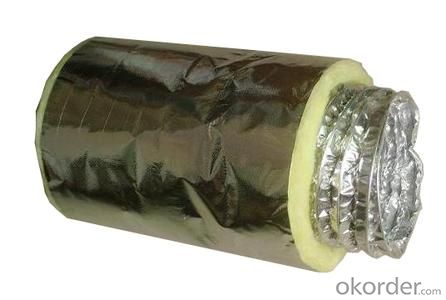
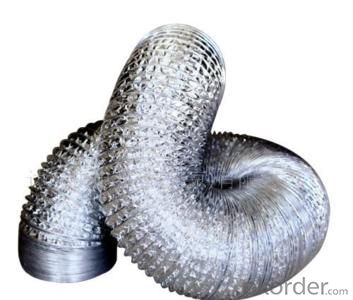
FAQ of Aluminium Flexible Duct:
1. What temperature maximum? Our products: 150℃ and 250℃
2. What MOQ? Our MOQ: 500 pcs
3. What payment terms? We accept T/T and L/C
4. Lead time: 10 days
5. Packing: Nest packing for non-insulated flexible duct, then into plastic bag for non-insulated flexible duct or packed in individual carton box.
- Q: What precautions should be taken when using aluminum foil facing in construction or other applications?
- <p>When using aluminum foil facing, safety measures include ensuring proper ventilation to prevent build-up of fumes, wearing protective gear such as gloves and masks to avoid skin and respiratory irritation, and following manufacturer's guidelines for safe handling and application. It's also crucial to avoid contact with open flames or high heat sources as aluminum foil can melt or ignite. Always clean up spills immediately to prevent slipping hazards and ensure that the working area is well-lit to avoid accidents.</p>
- Q: Is it safe to use aluminum foil as a wrapping material for food to be fried?
- <p>Yes, you can use aluminum foil to wrap food and fry it. Aluminum foil is heat resistant and can withstand high temperatures, making it suitable for frying. However, it's important to ensure that the foil is securely wrapped around the food to prevent any oil from seeping in and to avoid any foil from breaking off into the oil, which could be a fire hazard. Always follow safety guidelines when deep frying with aluminum foil to prevent accidents.</p>
- Q: What are the methods to avoid aluminum leaching from aluminum foil into food during cooking or storage?
- <p>To prevent aluminum from leaching into food when using aluminum foil facing, avoid direct contact between the foil and acidic or salty foods, as these can cause the aluminum to leach. Do not use aluminum foil at high temperatures, as it can degrade and release aluminum particles. Opt for aluminum-free alternatives like parchment paper or silicone baking mats for lining pans or wrapping foods. When using aluminum foil, ensure it's the heavy-duty type, which is less likely to break down and release aluminum. Always wash hands and utensils that have come into contact with aluminum foil to minimize ingestion of any residual aluminum.</p>
- Q: This question asks for methods to clean aluminum foil that has excess oil on it after cooking or food storage.
- <p>To remove excess oil from aluminum foil facing after cooking or food storage, you can follow these steps: 1. Allow the foil to cool down to avoid burns. 2. Use a paper towel to blot and absorb the excess oil. 3. For stubborn oil, you can wipe the foil with a damp cloth or sponge with a mild dish soap. 4. Rinse the foil thoroughly with warm water to remove any soap residue. 5. Dry the foil with a clean towel or let it air dry. If the oil is extremely stubborn, consider using a gentle scrubber or baking soda paste to help remove it. Always check the foil for any damage or wear before reusing it.</p>
- Q: Is it possible to recycle aluminum foil with a facing layer in my country?
- <p>Yes, aluminum foil with a facing layer can often be recycled, but the process may vary by country. In many countries, aluminum foil is recyclable, including the type with a plastic or paper facing. However, it's important to check with your local recycling program, as some facilities may not accept it due to the difficulty in separating the layers. If your local program doesn't accept it, you might need to find a specialized recycling center that can handle this type of material.</p>
- Q: Is it safe and effective to use aluminum foil with a reflective side for baking purposes?
- <p>Yes, aluminum foil facing can be used for baking. The shiny side of aluminum foil is often used to cover baking dishes to prevent food from drying out, to create a steam effect, or to reflect heat for even cooking. However, it's important to avoid direct contact between the foil and the heating elements of the oven to prevent fire hazards. Always follow the manufacturer's guidelines for safe use and placement of aluminum foil in your oven.</p>
- Q: This question asks for methods to store aluminum foil to prevent damage and rusting.
- <p>Aluminum foil is resistant to rusting, but it can still be damaged if not stored properly. To store aluminum foil, keep it in a cool, dry place away from direct sunlight. Use an airtight container or a resealable plastic bag to protect it from moisture and air, which can cause it to oxidize and lose its shine. Avoid stacking heavy items on top of it, as this can cause dents and tears. If you have a large amount, consider using a foil storage box with compartments to keep it organized and protected.</p>
- Q: What are the potential health hazards linked to cooking with aluminum foil?
- <p>Cooking with aluminum foil is generally considered safe, but there are some potential health risks. Aluminum can leach into food, especially when it comes into contact with acidic or salty foods at high temperatures. This could lead to increased aluminum intake, which has been linked to neurological disorders like Alzheimer's disease, although more research is needed to establish a definitive link. Additionally, aluminum foil can cause burns or injuries if not handled properly. It's important to use foil responsibly, avoiding direct contact with food when possible, and to follow proper food safety guidelines.</p>
- Q: What are the particular criteria or considerations when choosing aluminum foil facing materials?
- <p>When selecting aluminum foil facing, specific requirements include the foil's thickness, which affects durability and insulation properties; surface finish, which can impact heat reflection and aesthetics; and the type of adhesive used for bonding, which should be resistant to heat and moisture. Additionally, the foil should have good barrier properties to prevent moisture and air infiltration, and it should be compatible with the substrate materials to ensure a strong bond. Compliance with safety and environmental standards is also crucial.</p>
- Q: This question asks for methods to clean the aluminum foil facing, which is a common household material used for cooking and food storage.
- <p>To clean aluminum foil facing, start by removing any visible debris. Use a damp cloth or sponge with mild dish soap to wipe the surface gently. Avoid abrasive materials that could scratch the foil. If there are stubborn stains, you can use a mixture of water and vinegar (1:1 ratio) to dampen the cloth. Wipe the surface and let it air dry. For baked-on food, you can use a plastic scraper or a soft nylon brush to gently remove it. Always remember to handle aluminum foil carefully to prevent tearing or damaging the surface.</p>
Send your message to us
Aluminum Foil Facing Insulated Flexible Ductings HVAC Ducting for Air Conditioning
- Loading Port:
- Shanghai
- Payment Terms:
- TT or LC
- Min Order Qty:
- 500 pc
- Supply Capability:
- 50000 pc/month
OKorder Service Pledge
OKorder Financial Service
Similar products
Hot products
Hot Searches
Related keywords
